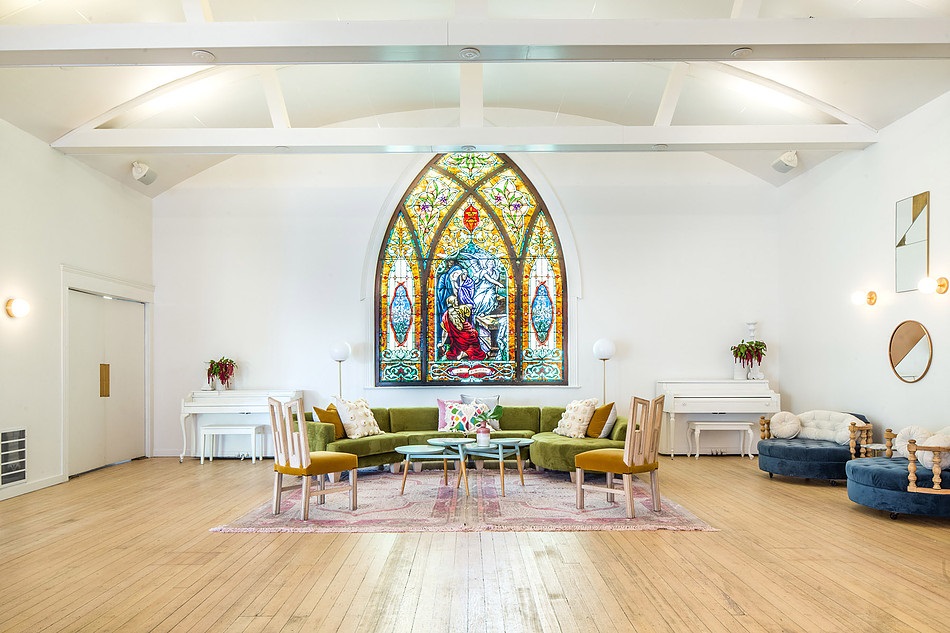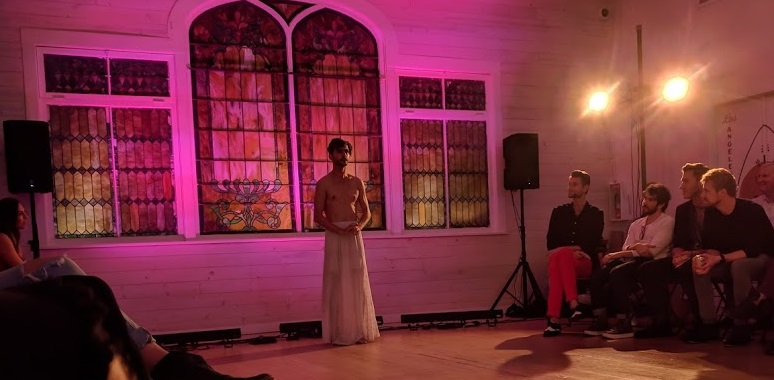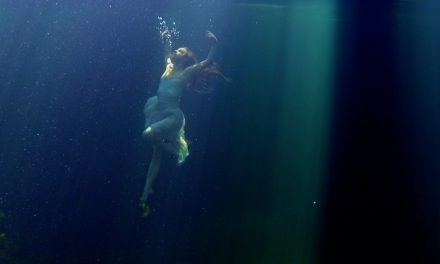The Ruby Street, a beautiful structure that has operated as a Suffragette house, a civil rights meeting place and a progressive church, was the venue for Andrew Pearson’s latest work, Dearly Beloved: A Union, Out of Wedlock. The owners, musicians Zach Leigh and Lourdes Hernández, first renovated the 4,000 square foot Arts and Crafts building as a performance space for musicians. After receiving requests to rent it as a wedding venue, however, they transformed the church into what it is today: a more than 8,300 square foot indoor-outdoor venue used for dinners, film screenings, weddings, film shoots and performances.
Pearson has performed with BODYTRAFFIC, Clairobscur Dance, String Theory, LollieWorks, The Union Project Dance Company and Los Angeles Contemporary Dance Company (LACDC). After leaving LACDC, he founded bodies in play, a vehicle for what he calls “a playground for the Visions and Values of Andrew Pearson”. On his website he writes that he wants to make serious art, without taking it too seriously. Dearly Beloved is a thoughtful work that touches on very serious issues of gender identity and what constitutes a “normal” relationship. Pearson approached these sensitive subjects with great tenderness, clarity and humor.
Dearly Beloved was presented by The Ruby Street wedding chapel and Dev Bajaj, of Deviate Studios, with installation art by Los Angeles, California and Chattanooga, Tennessee based artist Mary Margaret Groves. As the audience arrived, each person was given a rainbow-colored braided bracelet and a small cardboard box tied up in red ribbon that was not to be opened until instructed. As with a formal wedding, we were given seating either on the bride’s side or the groom’s side of the aisle. The bridesmaid and best man, both dressed in red and black, met audience members at the entrance to give a guided tour of the building and/or to usher them to their seats. My partner and I were seated on the bride’s side of the chapel.
Two rows of folding chairs lined the chapel. At one end was a tent like structure made of white cloth, lined with red carnations. At the other end stood a sculpture that with a mirrored headless torso, white wedding lace material and a fake hand holding a bouquet. It was an abstract representation of the bride to be and it was gender non-specific.
The bridesmaid and best man (Marissa Moses and Trevor Dow) began the performance by welcoming us and talking through a synopsis of their complex relationship before ceremoniously walking down the aisle to escort the bride across the chapel and into the white tent.
The work was divided into two sections titled The Ballad of Lady M (a solo performed by Pearson) and ii, a duet for him and Tiffany Sweat. For the solo, Pearson entered dressed in a long white skirt and bare top. The nails on his right hand were painted a reddish pink, with his left nails left natural; a sign of the character’s gender issues? Did this person identify as a man or a woman or was this a person who thinks of them self as having strong traits of both sexes? Without giving away any secrets, this character has moments of multiple personae and it is both very funny and sadly tragic.
The sound design by Ben Jehoshua and Pearson’s script highlighted his mood shifts from sad to the lighthearted and helped intensify Pearson’s alternating personae with sounds of wind, bells, muffled voices and a loud ticking clock. Pearson shifted back and forth between his male, female or super gay personae with the same ease he executes his choreography. His lip syncing was almost perfect; an accomplishment that one does not often experience with dancers.
Pearson moved his characters onto and off the floor with that same precision, but he did not always spare us from the sound of his body contacting the wooden floor. The movement, including the falls, echoed his intent and/or the inner struggle of his characters’ emotions. If anything, the movement became repetitive, but Pearson skillfully shifted how he executed it.
Without overtly politicizing his work, Pearson expressed the internal battle humans experience who do not live by society’s rules of normalcy. His characters personified stereotypes without making any final judgements of right or wrong, and he opened the door for others to draw the map of their own journey. Pearson’s movement was at times violent but always directed inwardly, and those times would end with a stillness and the appearance of internal conflict.
When the beautiful Tiffany Sweat joined him for ii, the music changed to evoke these two moving to a disco like beat. They quietly boogied, partnered on the floor and used subtle upper body popping moves as we followed their relationship through its ups and downs. There was a moment of separation where Pearson’s character appeared to be having second thoughts, but in the end, they reunited in a final pose that reminded me of the figures atop a wedding cake. It is not clear, nor does it matter, if those two were ever wed, but their own narrative had been written.
The Ruby Street was the ideal venue for Dearly Beloved, but I question if it would translate to a proscenium situation or if Pearson even has plans to present it in one. The duet, ii, was charming and performed quite well, but I left wondering if it would be memorable.
The warm ceremonial atmosphere lighting was by Erik Speth; the Music Composition by Kevin DeKimpe and John “The Hound” Constantine; with Voiceover Performance by Michael Dunn. Lisa Bierman was the Script Consultant and the other actors included Marissa Moses, Janelle Junio, Trevor Dow, and Rachel Rosenbloom.
For more information about bodies in play, click here.
For more information about The Ruby Street, click here.
Featured image: Andrew Pearson – Photo by Roger Martin Holman for LA Dance Chronicle.














